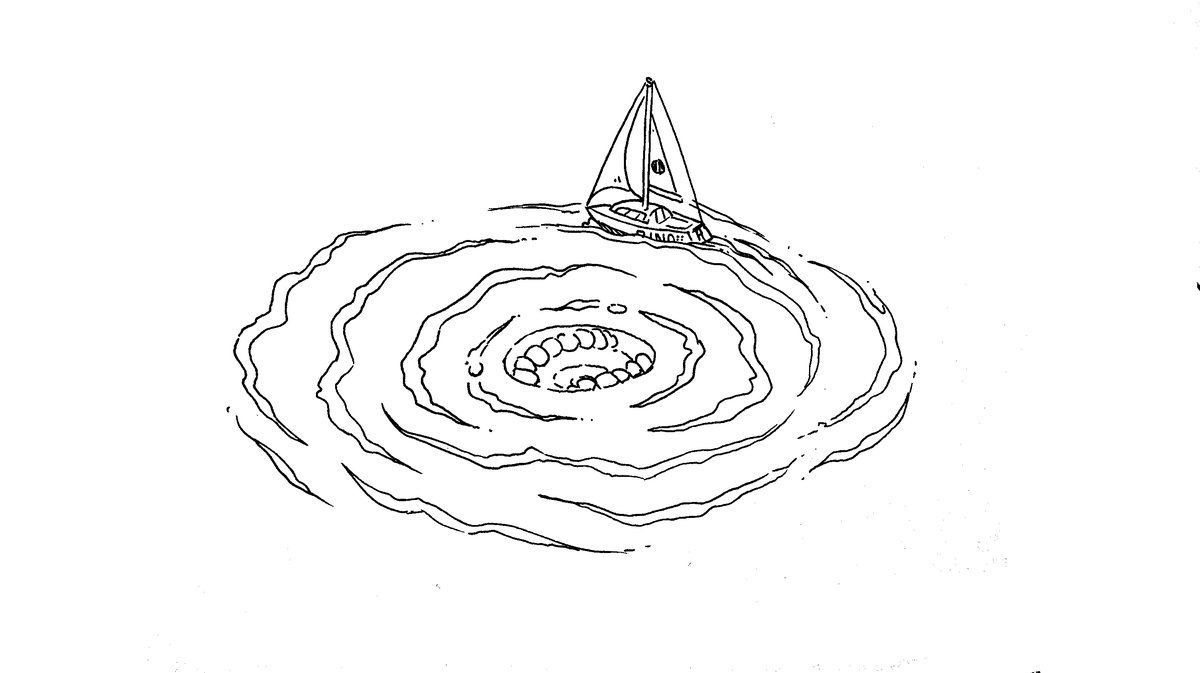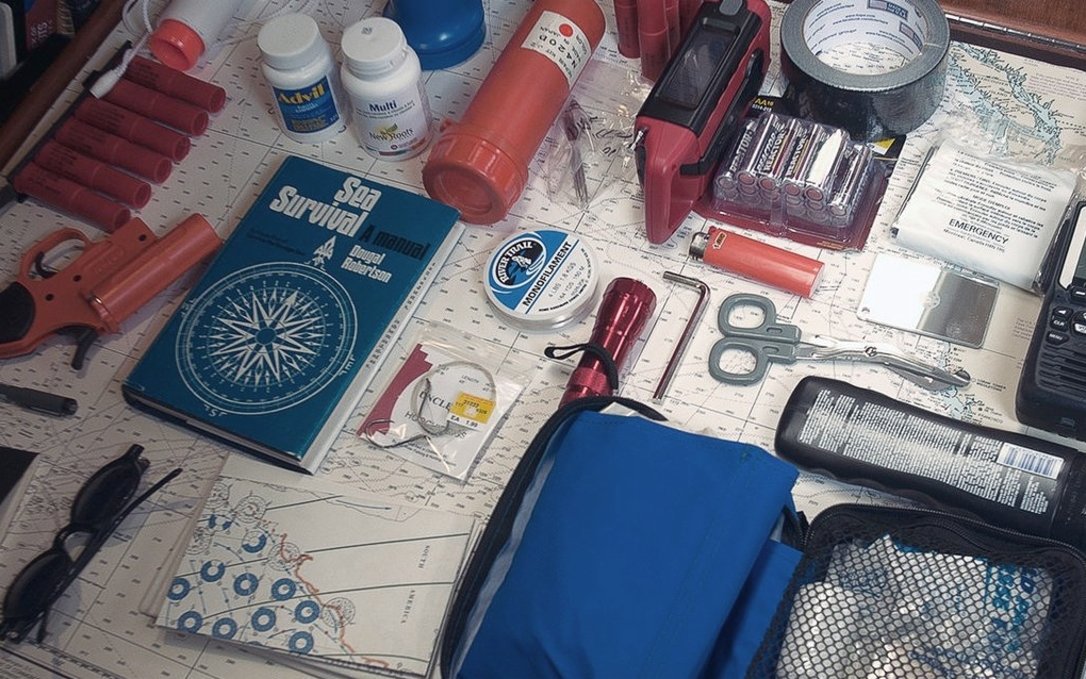safety gear

They who let the sea lull them into a sense of security is in very grave danger.Hammond Ines
Things can happen, even on a calm ocean, so it is necessary to be alert and to not underestimate the water's strength and unpredictability. Never be complacent, and don't trust the sea.
Safety gear with auto-inflating systems need to be inspected often, and you must carry spares. Safety gear will last you many years if serviced regularly.
Pyrotechnic signaling devices (including aerial flares and hand held signals) expire 42 months after the date of manufacture in accordance with the Coast Guard requirements. Typically, this means that you must replace your flares every three boating seasons. Aerial flares cost $75 per pack of 6 (in Canada), for a boat our size (10 m) we need to have 12 aboard.
Life jackets. Wear a life jacket (with a sailing harness) and tether (especially when night sailing). The jackets need to be serviced every 3 years, so that the auto-inflating canisters can be tested, and replaced. Replacement cartridges for auto-inflating PFDs cost about $35 CAD. If planning to travel for many years out of the country, carry replacement cartridges onboard, because other countries may not carry the ones required by your model and that replacements can't be shipped by air since they're pressurized.
Life jackets that are not auto-inflating are fine, but must have a sailing harness to which you can clip a short tether. If the tether is short enough, you won't fall overboard and won't require extra flotation. Floating life jackets that are non-inflating are bulky, and may make it difficult, or uncomfortable to sail in. Wearing a short tether that keeps you to the boat, and prevents you from falling too far overboard is your best security. We recommend a short tether with two clips, so you can clip to another point on the boat while always being clipped on elsewhere.
life rafts. Re-packing a liferaft is very expensive, and varies depending on the model, and your location in the world.
Jacklines. Run jacklines along the deck, from the bow to stern cleats, and keep them within the standing rigging. Make sure the jacklines are flat, and brightly colorful so as to be visible at night. Rope jacklines can trip you up. An even better option for jacklines, is to keep them running as close to the center of the boat as possible, so that there is no chance of falling overboard when attached. Jacklines have to be made from a strong, UV resistant material, you can buy them, but we had ours made.
first aid kit
Basic First-aid kit:
Clearly mark the first-aid kit with a red cross, and make sure everyone aboards knows where it is. Keep a list inside of the items you use, and be sure to top off the kit every year or so. Also, see ditch bag.
- Sterile gauze pads (dressings) in small and large squares to place over wounds
- Medical tape
- Roller and triangular bandages to hold dressings in place or to make an arm sling
- Adhesive bandages in assorted sizes
- Scissors
- Tweezers
- Safety pins
- Instant ice packs
- Disposable non-latex gloves(such as surgical or examination gloves)
- Flashlight(with extra batteries in a separate bag)
- Antiseptic wipes or soap
- Pencil (and sharpie) and pad
- Emergency blanket
- Eye patches
- Thermometer
- A first aid manual
Basic Medicine kit:
Always read about a medicine before using it. If administering medicine to another person, ask about their allergies, and past medical history, last oral intake etc. Some medicines can cause severe allergic reactions, or may interact with other medicine.
Never administer anything to anyone without their consent.
- Ibuprofen (Oral. Minor pain, and fever reducer, e.g., toothache, menstruation cramps, headache)
- Aspirin (Oral. Pain, fever, inflammation reducer, e.g., treat/prevent heart attacks, strokes, chest pain)
- Antihistamines (allergy relief)
- Seasickness meds (scopolamine patches, dimenhydrinate(dramamine) etc)
- Ear drops
- Eye wash
- Insect repellant (mosquitoes can carry malaria, or dengue)
- Hand sanitizer
- Topical anesthetic
- Zithromycin (Oral. Treatment of bacterial infections, e.g., traveler's diarrhea, gastrointestinal infections etc)
- Oxycodone/Acetaminophen (Oral. Severe pain relief, fever reducer)
- Sunscreen (SPF 30)
- Aloe vera gel with lidocaine (for burn relief)
- Bacitracin/Polysporin/Neosporine (Topical ointment. Prevents infection. For minor scrapes, cuts, and burns)
- Hydrogen peroxide
- Imodium (anti-diarrhea)
Advanced Medicine kit add-ons:
- Hot water bottle (for hypothermia)
- Staple gun (for wounds)
- Epinephrine (vials, or Allerject/AUVI-Q. Avoid EpiPens, they are grifters)
- Tourniquet
- Multitool
- Compression bandage
- Reinforced sterile skin closures
- CPR pocket mask
- Povidone surgical scrubs (iodine)
- Sterile sutures thread with needle
- Emergency dental kit
ditch bag

Every boat should have a ditch bag, that is, a bag filled with emergency supplies in case the boat needs to be abandoned. Remember though, you should only ever have to step UP into a liferaft. Don't be too quick to abandon your boat, boarding a liferaft ought to be a last resort. In a panic, sailors board their liferafts too soon, with their boat found later, still afloat.
The ditch bag should have:
- A handheld vhf
- Spare batteries
- Noise-producing device (whistle, horn)
- Flashlight
- Water rations (4L/week for 2 ppl)
- Calorie-dense food rations (ex: 280-400 cal energy bars)
- Charts
- A good knife
- Multitool
- Sextant
- Sunscreen (SPF 30)
- Lighter & 1 pack of waterproof matches
- first aid kit
- Fish line & fish hooks
- Mirror
- Compass
- Duct tape
- Flare gun
- Emergency blanket
- Tarp, for sun protection & as vapor barrier for a hypothermia wrap(see medical).
- PLB(personal locator beacon), or EPIRB